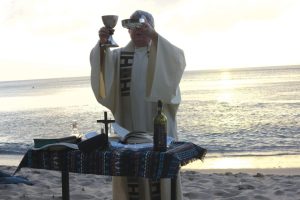 Even if St. Francis of Assisi wasn’t an environmentalist in the modern sense of the word, Keith Warner, OFM finds modern Catholics can learn a lot from his love for creation.
Even if St. Francis of Assisi wasn’t an environmentalist in the modern sense of the word, Keith Warner, OFM finds modern Catholics can learn a lot from his love for creation.
[Read more from Keith Warner on Catholic environmentalism.]
Was St. Francis of Assisi really an environmentalist?
St. Francis was a great lover of God’s creation, before there was such a word as environmentalist. He exemplifies many of the best attributes of what it means to be an environmentalist today, but he was not an environmentalist in the modern sense of the word.
What can 21st-century Catholics learn from St. Francis?
My recommendation is to look to Francis as an example of someone who prayed in nature and discovered more about God and himself through the practice of contemplative prayer in nature. Francis spent a third to half of each year praying in nature and the wilderness, living in hermitages, caves, under lean-to’s, on mountainsides, and he interspersed this with preaching. There was something about that experience of being intimately related to creation itself that helped him grow more fully into the mystery of God. And that’s what we are desperately in need of today, because we are so alienated from the earth and from ourselves.
His life doesn’t seem like one we could imitate. Where do you see the practical example of St. Francis for ordinary Catholics in the United States?
Pope John Paul II named Francis the patron saint “of those who promote ecology” in 1979. Ecology in Europe refers to what we in the United States call environmentalism and not just the science.
Francis is the patron of those who cultivate ecological consciousness, but that means a lot more than being the patron of environmental educators. His example really points to a mystical or a spiritual vision for all of the creative world as brother and sister, as he describes in his Canticle of the Creatures.
Part of what we have to recover–which has been so thoroughly lost in our modern understanding of the world–is a sense of enchantment. Scripture assumes an enchanted world. The problem is we can’t even recognize it in scripture because we live in a world that’s been stripped of its meaning and is defined as material only.
Moving beyond the saccharine bird-bath image of Francis requires prayer but also a little more scientific literacy. We have to learn something about the material relationship of the earth and humanity, but we also have to understand this relationship more broadly as a spiritual community.
We may not wear rags, live in a cave for several months of the year, and eat only gruel and bread and nuts and berries. As a Franciscan, I don’t do that either. But we can choose to create a community that’s charged with religious meaning, that sees the sacraments as a part of a broader sacramental vision of the material world, that sees the material world as charged with the grandeur of God.
This article was published in the April 2010 of U.S. Catholic (Vol. 75, No. 4, page 25). It accompanies Religious by nature.
Image credit: St. Francis Preaching to the Birds by Giotto.













Add comment